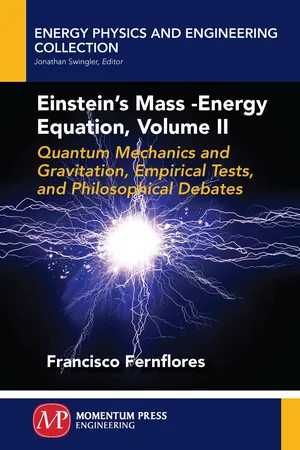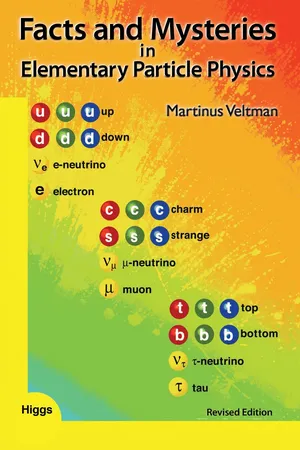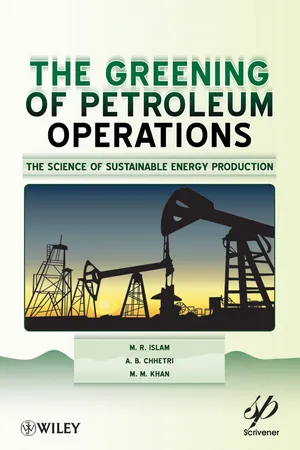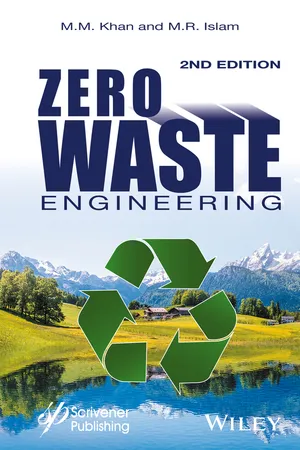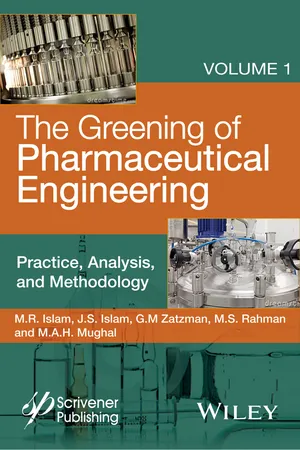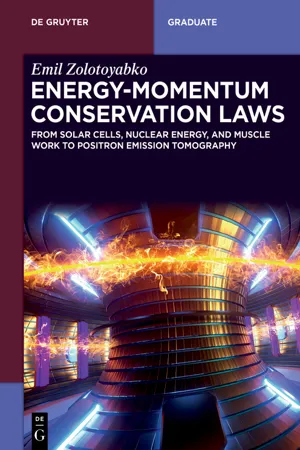Chemistry
Mass Energy Conversion
Mass energy conversion refers to the principle, described by Einstein's famous equation E=mc^2, that mass can be converted into energy and vice versa. This concept has profound implications in nuclear reactions and the understanding of atomic structure. It explains how a small amount of mass can release a large amount of energy, as demonstrated in nuclear power and atomic bombs.
Written by Perlego with AI-assistance
Related key terms
Related key terms
1 of 4
Related key terms
1 of 3
7 Key excerpts on "Mass Energy Conversion"
- eBook - ePub
The Really Useful Science Book
A Framework of Knowledge for Primary Teachers
- Steve Farrow, Amy Strachan(Authors)
- 2017(Publication Date)
- Routledge(Publisher)
2 , showed that mass and energy were theoretically interconvertible (e = energy; m = mass; c = the speed of light, a constant).It is now known that, when matter releases its energy, a small loss of mass results. In normal chemical reactions, the rate of conversion of mass to energy is so small that it is difficult to measure accurately. In nuclear reactions, however, so much energy is released that the change in mass is large enough to be measurable.The effects of the bonding forces within and between atoms and molecules can be classified in terms of a variety of primary energy sources, resulting in a range of further sources of transferable energy:• bonding within atoms (strong nuclear force) gives rise to nuclear energy;• bonding and transfer between atoms and molecules (weak nuclear and electromagnetic forces) gives rise directly to chemical, electromagnetic and strain energy;• gravity (the force of attraction between masses) gives rise to potential and kinetic energy.Famous scientist factboxName Albert Einstein (1879–1955), German physicist Link to NC Year 5 – Forces Famous for He produced one of the most famous equations of all time: E = mc2 (energy equals mass multiplied by the speed of light squared)He also developed the theory of relativity. Imagine it is raining, and the rain is blowing against your back. If you ran, the rain wouldn’t hit your back as hard, travelling more slowly than you. Scientists would say the rain was travelling more slowly relative to you Working scientifically Einstein was a problem-solver. He had a strategy of breaking down problems and solving them in stages Impact on society For cars and phones to have accurate GPS (global positioning system), satellites have to take Einstein’s relativity theory into account. Satellites are travelling quite fast and, as they are about 20,000 km above Earth, experiencing gravity that is weaker, so the relativistic effects need to be taken into account to maintain accuracy. Einstein’s famous equation relating mass and energy was the basis for developing nuclear power, which may help us to develop clean, cheap and abundant energy in the future - eBook - ePub
- Francisco Fernflores(Author)
- 2017(Publication Date)
- Momentum Press(Publisher)
matter being converted into energy. As we shall see, this way of talking about Einstein’s result is rooted in the history of nuclear physics, though it is now widely considered to be rather misleading.3.1 “EQUIVALENCE” AND “CONVERSION” OF MASS AND ENERGY
In a somewhat polemical article titled “Energy has mass: A common misunderstanding is re-examined,” Bondi and Spurgin set out to displace, once and for all, what they take to be fundamental misunderstandings in the way Einstein’s famous equation is taught to students and explained to all of us [35] . Specifically, Bondi and Spurgin are critical of any attempt to talk about mass and energy being “interconvertible” or any other related assertions such as the claim that mass can be “converted” into energy. Similarly, Bondi and Spurgin encourage us to warn students not to be misled by talk about “the equivalence of mass and energy.” When it comes to the section of their paper titled “Getting It Right,” Bondi and Spurgin cite exactly three specific statements, which they take to be the only correct statements, that students should learn:(i) Energy has mass;(ii) Energy is always conserved;(iii) Mass is always conserved [35, p. 63].Unsurprisingly, like other attempts to regulate the use of language that seem just a little too far-reaching, their paper was met with a swift response. However, by examining how Bondi and Spurgin support their views, and the response by Peierls [36] , we can appreciate more deeply how best to understand philosophically the mass–energy relation.Bondi and Spurgin begin by presenting a counter-argument against any talk of the conversion of mass and energy that treats this conversion as analogous to a currency conversion. Bondi and Spurgin say: - Martinus J G Veltman(Author)
- 2018(Publication Date)
- WSPC(Publisher)
In particle physics this equation is a fact of daily life, because in inelastic processes, where the set of secondary particles is different from the primary one, there is no energy conservation unless one includes these rest-mass energies in the calculation. As the final particles have generally masses different from the primary ones, the mass-energy of the initial state is in general different from that of the final state. In fact, the first example that has already been discussed extensively is neutron decay; this decay is a beautiful and direct demonstration of Einstein’s law, E = mc 2. Indeed it is in particle physics that some very remarkable aspects of the theory of relativity are most clearly demonstrated, not just the energy-mass equation. Another example is the lifetime of unstable particles, in particular the muon. The lifetime of a moving muon appears to be longer in the laboratory, in accordance with the time dilatation predicted by the theory of relativity. Thus the mass-energy must be included when considering the relation between energy and momentum. The figure shows the relation between energy and momentum for two different particles, respectively with masses m and M. We have taken M three times as large as m. For zero momentum the energy is simply mc 2 for the particle of mass m and mc 2 for the particle of mass M. This figure is really the all-important thing in this Chapter. Understanding it well is quite essential, since we shall draw a number of conclusions from it. In itself it is simple: the curve shows the relation between momentum and energy for a single particle. Given the momentum of a particle of mass m one can find the corresponding energy by using the curve for mass m. If the momentum is zero then the energy is mc 2. In drawing the figure one must make a choice of units. We have drawn a figure corresponding to a choice of units such that the speed of light is one- eBook - ePub
The Greening of Petroleum Operations
The Science of Sustainable Energy Production
- M. R. Islam, A. B. Chhetri, M. M. Khan(Authors)
- 2011(Publication Date)
- Wiley-Scrivener(Publisher)
This description is consistent with Einstein’s revolutionary relativity theory, but does not rely on Maxwell’s equations as the starting point. The resulting equation is shown to be continuous in time, thereby allowing transition from mass to energy. As a result a single governing equation emerges. This equation is solved for a number of cases and is shown to be successful in discerning between various natural and artificial sources of mass and energy. With this equation, the difference between chemical and organic fertilizers, microwave and wood stove heating, and sunlight and fluorescent light can be made with unprecedented clarity. This analysis would not be possible with conventional techniques. Finally, analysis results are shown for a number of energy and material related prospects. The key to the sustainability of a system lies within its energy balance. Khan and others recast the combined energy-mass balance equation in the following form as in Equation 3.9. Dynamic balances of mass, energy and momentum imply conditions that will give rise to multiple solutions, at least with the currently available mathematical tools. In this context, Equation 3.9 is of utmost importance. This equation can be used to define any process to which the following equation applies: (3.10) In the above classical mass balance equation, Q in expresses mass inflow matter, Q acc represents the same for accumulating matter, and Q out represents the same for outflow matter. Q acc will have all terms related to dispersion/diffusion, adsorption/desorption, and chemical reactions. This equation must include all available information regarding inflow matters, e.g., their sources and pathways, the vessel materials, catalysts, and others. In this equation, there must be a distinction made among various matter based on their source and pathway. Three categories are proposed: 1) biomass (BM); 2) convertible non-biomass (CNB); and 3) non-convertible non-biomass (NCNB) - eBook - ePub
Zero Waste Engineering
A New Era of Sustainable Technology Development
- M. M. Khan, M. R. Islam(Authors)
- 2016(Publication Date)
- Wiley-Scrivener(Publisher)
–9 gram. Because no attention is given to the source of the matter nor of the pathway, the information regarding these two important intangibles is wiped out from the conventional scientific analysis. The fact that a great amount of energy is released from a nuclear bomb is then taken as evidence that the theory is correct. By accepting this at face value (heat as a one-dimensional criterion), heat from nuclear energy, electrical energy, electromagnetic irradiation, fossil fuel burning, wood burning or solar energy, becomes identical.In terms of the well-known laws of conservation of mass (m), energy (E) and momentum (p), the overall balance, B, within Nature may be defined as some function of all of them:(4.1)The ‘perfection-without-stasis’ that is Nature means that everything that remains in balance within it is constantly improving with time. That is:(4.2)If the proposed process has all concerned elements so that each element is following this pathway, none of the remaining elements of the mass balance discussed later will present any difficulties. Because the final product is being considered as time extends to infinity, the positive (“>0”) direction is assured.4.3 Continuity of Matter and Phase Transition
By introducing time-spans of examination unrelated to anything characteristic of the phenomenon itself being observed in nature, discontinuities appear. These are entirely removable, but they appear to the observer as finite limits of the phenomenon itself, and as a result, the possibility that these discontinuities are removable is not even considered. This is particularly problematic when it comes to the matter of phase transitions of matter and the renewability or non-renewability of energy. - M. R. Islam, Jaan S. Islam, Gary M. Zatzman, M. Safiur Rahman, M. A. H. Mughal(Authors)
- 2015(Publication Date)
- Wiley-Scrivener(Publisher)
−9 (i.e., 0.000000001) gram. Because no attention is given to the source of the matter nor the pathway, the information regarding these two important intangibles is wiped out from the science of tangibles. The fact that a great amount of energy is released from a nuclear bomb is then taken as evidence of the theory’s correctness. By accepting this at face value (heat as the one-dimensional criterion), heat from nuclear energy, electrical energy, electromagnetic irradiation, fossil fuel burning, wood burning or solar energy become identical. This, of course, has tremendous implications for the underlying economics and future engineering and project planning.Newton in a previous era and Einstein in the modern era are both credited with having the proper grasp of time and energy (e.g., light). Newton’s work has been deconstructed by Islam et al. (2010). It has been demonstrated that post-Newton science recognized the inherent connection between mass and force, but disconnected mass from energy. Energy itself was connected rather to work — “useful work” — that submits to measurement of the spatial difference between two states in time.The ‘ability to work’ is considered to be energy, while the term ‘work’ itself denotes displacement of an object. Thus, for example, if an object is moved around and brought back to the original place, no (net) work has been performed on it. By definition, the pathway or the time function mooted in the definition of the process, effectively ‘disappears’ the track of actual work performed.In addition, and by way of a similar ‘magic act’, any ‘work’ is also related to ‘heat’. This notion dates back to Lord Kelvin’s notion of the universe as continually running down to a point projected in the future of becoming “dead” eventually. This approach incidentally also removes any dissimilarity between sunlight and solar heat from electric light and electrical heating. It also conflates energy produced from food with energy produced from, e.g., gasoline.- eBook - ePub
Energy-Momentum Conservation Laws
From Solar Cells, Nuclear Energy, and Muscle Work to Positron Emission Tomography
- Emil Zolotoyabko(Author)
- 2024(Publication Date)
- De Gruyter(Publisher)
8 Energy transformationThe energy conservation law means that energy cannot be created or annihilated, but only transformed from one form into another. In previous chapters, we discussed selected examples of energy transformation, for example, transformation of kinetic energy into the potential energy of a gravitational field or into the potential elastic energy of a compressed spring (see Chapter 1). Another example is transformation of light (photon) energy into different forms of electrical energy (Chapter 5).Because of the great importance of this issue to the general understanding of the energy conservation law, here we analyze the working principles of combustion engines and muscle contraction, both of which occur at the expense of transforming chemical energy stored in molecular bonds into mechanical energy. We also discuss the photosynthesis process in plants, a key example of transforming light energy into stored chemical energy. At the end, we briefly review the field of thermoelectricity, in which waste heat (more exactly, heat gradients) is transformed into electricity and vice versa.8.1 Transformation of chemical energy into mechanical energy: the internal combustion engine
If you ask me about the most common signs of technological human activity on the surface of the Earth, I immediately say that these are gas (gasoline/petrol) stations. They are everywhere, in every city and village, in the countryside, along every road on all continents. Gas stations indeed are the symbol of the energy revolution, which began in the 1860s with the invention of the internal combustion engine by Nicolaus Otto. He was the first to use the mixture of liquid fossil fuel and air for converting the chemical energy of hydrocarbon fuels into mechanical energy toward moving a vehicle.Hydrocarbon fuels are composed of hydrogen and carbon and release large amounts of energy (about MJ/mol) upon burning, that is, when reacted with oxygen. For example, the burning reaction of the simplest hydrocarbon, methane (CH4
Index pages curate the most relevant extracts from our library of academic textbooks. They’ve been created using an in-house natural language model (NLM), each adding context and meaning to key research topics.
Explore more topic indexes
Explore more topic indexes
1 of 6
Explore more topic indexes
1 of 4

